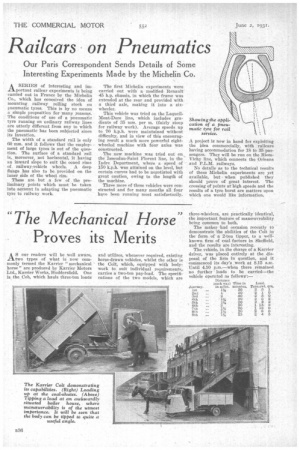CC The Mechanical 1-lorse"
Page 54

Page 55

If you've noticed an error in this article please click here to report it so we can fix it.
Proves its Merits
AS our readers will be well aware, two types of what is now commonly termed the Karrier "mechanical horse" are produced by Karrier Motors Ltd., Earlier Works, Huddersfield. One is the Cob, which hauls three-ton loads and utilizes, whenever required, existing horse-drawn vehicles, whilst the other is the Colt, which, equipped with bodywork to suit individual requirements,; carries a two-ton pay-load. The specifications of the two models, which are
three-wheelers,. are Practically identical, the important feature of manoeuvrability being common to both.
The' maker -had occasion recently to demonstrate the abilities of the Colt in the form of a 2-ton tipper, to a wellknown firm of coal factors in Sheffield, and the results are interesting.
The vehicle, in the charge of a Karrier driver, was placed entirely at the disposal of the firm in question, and it commenced its day's work at 835 a.m. Until 4.10 p.m.—when there remained no further loads to be carried—the vehicle operated as follows :— Distance
(each way■ Time in Load.
Journey. in miles. minutes. Tons.ewt. qrs.
let ... 114 20 2 5 2n1 ... 20 2 1 r 40 2 5 4th 114 20 2 5 5th 11/4 20 2 8 2 ' 6th 2 20 1 13 2 7th 1% 20 118 0 8th 1% 30 2 8 0 9th 114 25 2 4 3
1 The total mileage was approximately 25 and the weight tons.
In delivering nearly 20 tons of coal in the day the Colt definitely accomplished the work of two single-horse vehicles, and had it carried on until 6 p.m.—to which time the horse-carts usually work—three more journeys would have increased the total weight by approximately six tons.
On analysing the results, we find that earned about 19-i out of the 7 hours 55 mins, during which the Colt was in operation, 3-hours 35 mins, constituted actual running time, and allowing one hour for dinner, 3 hours 20 mins, were left for loading, unloading and waiting.
It will be noted that, as the result of the fitting of a large body—its capacity was 90 cubic ft.—there was a general tendency to overload, hut this policy is, of course, not recommended. Incidentally, the petrol consumption for the whole day's work was 11 gallons.
From the information we have received it would appear that the demonstration was entirely successful, and it clearly shows that for short-distance hauls, for which purpose both the Colt and Cob were specifically designed, the Karrier "mechanical horse" has an undisputed pull over its flesh-and-blood brother. The mechanical tractor is not consuming a daily ration of costly food when it is off duty.




































































































